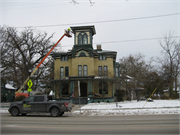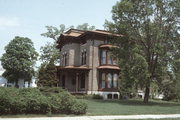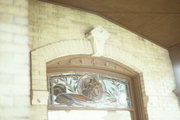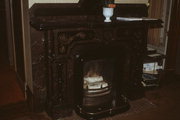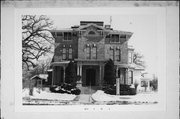Property Record
507 N GRAND AVE
Architecture and History Inventory
| Historic Name: | Andrew Frame House |
|---|---|
| Other Name: | |
| Contributing: | |
| Reference Number: | 63236 |
| Location (Address): | 507 N GRAND AVE |
|---|---|
| County: | Waukesha |
| City: | Waukesha |
| Township/Village: | |
| Unincorporated Community: | |
| Town: | |
| Range: | |
| Direction: | |
| Section: | |
| Quarter Section: | |
| Quarter/Quarter Section: |
| Year Built: | 1879 |
|---|---|
| Additions: | |
| Survey Date: | 1982 |
| Historic Use: | house |
| Architectural Style: | Italianate |
| Structural System: | Balloon Frame |
| Wall Material: | Cream Brick |
| Architect: | Edward Townsend Mix |
| Other Buildings On Site: | |
| Demolished?: | No |
| Demolished Date: |
| National/State Register Listing Name: | Frame, Andrew, House |
|---|---|
| National Register Listing Date: | 10/28/1983 |
| State Register Listing Date: | 1/1/1989 |
| National Register Multiple Property Name: | Multiple Resources of Waukesha |
| Additional Information: | A 'site file' exists for this property. It contains additional information such as correspondence, newspaper clippings, or historical information. It is a public record and may be viewed in person at the Wisconsin Historical Society, State Historic Preservation Office. Architectural Description: The Andrew Frame residence, a fine Italianate styled building, was designed by Milwaukee architect, Edward Twonsend Mix and constructed under the supervision of local contractors Hartwell and Gleason. [B]. The cream brick building stands two full stories and includes an attic marked on the exterior by pairs of windows set in to the frieze and framed by brackets. The remainder of the windows appear in pairs (with the exception of a two story frame bay window on the south side) and are capped by stilted segmental arches with stone keystones. The facade contains a central pavilion, accented by a pediment at the roof line which breaks to frame a lunette window. The main roof is hipped and once included a large belvedere. The original cupola was removed in c. 1940. A frame porch composed of a central rectangular projection and curved wings extends across the facade. The residence is in excellent condition. It was owned in 1982 by Leonard G. Adent. Architectural Significance: Architecturally significant as an example of a period of construction, this carefully balanced design is among the best of examples of the cubical Italianate style remaining in Waukesha and is also an important example of the use of cream city brick. A frame carriage house, located north of the house (511 N. Grand Avenue, WK 79/16) has been remodeled and converted to commercial use, and is not considered significant due to recent remodelings. The Frame House is also a commercial property but has not been significantly altered on the exterior or the interior. The original woodwork, elaborate curved stair, parquet floors and marble fireplaces remain; remodeling has occurred in the original service area. Other important brick Italianate buildings remain at 348 Wisconsin Avenue (Street-Waite House, WK 4/24), 434 Madison Street (Blair House, WK 7/12), 609 E. Broadway (Buchner House, WK 38/23), and 307 E. Main (Moore House, WK 42/14). Historical Statement: The Frame House is historically significant due to its association with the life of Andrew J. Frame, long time President of the Waukesha National Bank, the County's first financial institution. Andrew J. Frame was born in Waukesha on February 19, 1844 in the small family house on Broadway, east of Grand Avenue. When Frame was President of the Waukesha National Bank, his office was only 150 feet away from his birthplace. After attending local schools, Frame entered employment at the Waukesha County Bank as an office boy at the age of 18. He quickly rose to bookkeeper, teller, and in 1865, assistant cashier. When William E. Blair assumed the Presidency of the bank in 1866, Frame was promoted to Cashier. At this time he was only 21 years of age. Upon Blair's death in 1880, Frame was named President, an office he held until 1919. In that year he "retired" to the position of Chairman of the Board which he held until the time of his death in 1932 at the age of 88. [C]. Frame was known for his leadership in state and national banking issues, particularly in leading opposition to allowing branch banking. He was deeply involved in local activities and, in 1926, donated the land along the Fox River now known as Frame Park. Throughout the late nineteenth and early twentieth centuries, Frame was considered the leading citizen of Waukesha. [D]. The First National Bank of Waukesha opened in 1855 as the Waukesha County Bank and has survived in several forms until the present. In 1865, the Bank reorganized as the Waukesha National Bank. In 1956, it became the First National Bank of Waukesha and in 1980, the Independence Bank of Waukesha. [D]. About the Architect: Edward Townsend Mix, designer of the Frame House, was born in New Haven, Connecticut in 1831 and entered an architectural office in 1848. In 1856, he moved to Milwaukee and the following year, he opened his own office in the city. Through the 1880's, Mix supplied the designed for many of the important public, commercial and residential buildings in Milwaukee and other Wisconsin cities. In Waukesha, the Chandler House (NRHP 1975) and the First Baptist Church (WK 4/29) are also attributed to Mix. Another map code is City Map #13. |
|---|---|
| Bibliographic References: | A. Griswold, "Old Homes and Their Owners," Landmark, I No. 2 p. 3. B. Waukesha Freeman Vol. XXI No. 38 September 18, 1879 p. 1. C. Dictionary of Wisconsin Biography, p. 133. D. "Waukesha County Bank was Organized in 1855," Waukesha Freeman Centennial Edition, Sec. L-I p. 8, 1959. E. Loerke, "Early Waukesha," Waukesha Co. Historical Museum, 1973. F. ZIMMERMAN #767. G. WAUKESHA FREEMAN "Woman takes on labor of love." 5/17/1996. |
| Wisconsin Architecture and History Inventory, State Historic Preservation Office, Wisconsin Historical Society, Madison, Wisconsin |

